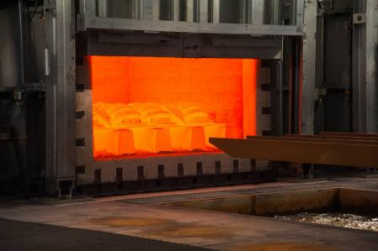- Scope of Application of Heat Treatment Processes
Heat treatment processes are widely used across various metal-heavy industries in daily life. For example, they are applied to automotive components and metal products in the medical industry.
- Introduction to Heat Treatment of Heat-Resistant Steel Castings
The heat treatment of heat-resistant steel castings refers to a process method in which steel is heated, held, and cooled in a solid state to alter its internal structure, thereby achieving the desired properties. The purpose of heat treatment is to significantly improve the thermal properties of steel, unlock its potential, and enhance the performance and lifespan of workpieces.
III. Methods of Heat Treatment Processes
- Annealing
Operation Method**: Heat the steel workpiece to a temperature of Ac3 + 30~50°C, Ac1 + 30~50°C, or below Ac1 (refer to relevant data), followed by slow cooling in the furnace.
Purpose:
- Reduce hardness, improve plasticity, and enhance machinability and workability.
- Refine grain structure, improve mechanical properties, and prepare for subsequent processes.
- Eliminate internal stresses caused by cold or hot working.
Key Application Points:
- Suitable for alloy structural steel, carbon tool steel, alloy tool steel, high-speed steel forgings, welded parts, and raw materials that fail to meet supply standards.
- Typically performed in the rough state.
- Normalizing
Operation Method: Heat the steel workpiece to 30~50°C above Ac3 or Accm, hold, and then cool at a slightly faster rate than annealing.
Purpose:
- Reduce hardness, improve plasticity, and enhance machinability and workability.
- Refine grain structure, improve mechanical properties, and prepare for subsequent processes.
- Eliminate internal stresses caused by cold or hot working.
Key Application Points:
Normalizing is often used as a preliminary heat treatment for forgings, welded parts, and carburized components. For low- and medium-carbon structural steels and low-alloy steels with modest performance requirements, it can also serve as the final heat treatment. However, for medium- and high-alloy steels, air cooling may cause full or partial quenching, making it unsuitable as a post-heat treatment.
- Quenching
Operation Method: Heat the steel workpiece above the phase transition temperature Ac3 or Ac1, hold for a period, and then rapidly cool in water, saltpeter, oil, or air.
Purpose:
Quenching is generally used to obtain a high-hardness martensitic structure. For certain high-alloy steels (e.g., stainless steel, wear-resistant steel), quenching aims to achieve a single, uniform austenitic structure to improve wear and corrosion resistance.
Key Application Points:
- Typically used for carbon and alloy steels with a carbon content exceeding 0.3%.
- Quenching maximizes the strength and wear resistance of steel but introduces significant internal stresses, reducing plasticity and impact toughness. Tempering is therefore required to achieve balanced mechanical properties.
- Tempering
Operation Method (for heat-resistant steel manufacturers): Reheat the quenched steel workpiece to a temperature below Ac1, hold, and then cool in air, oil, hot water, or water.
Purpose:
- Reduce or eliminate post-quenching internal stresses, minimizing workpiece deformation and cracking.
- Adjust hardness, improve plasticity and toughness, and achieve the desired mechanical properties.
- Stabilize workpiece dimensions.
Key Application Points:
- Low-temperature tempering is used to retain high hardness and wear resistance; medium-temperature tempering improves elasticity and yield strength while maintaining toughness; high-temperature tempering prioritizes impact toughness and plasticity while ensuring adequate strength.
- Avoid tempering carbon steels at 230~280°C and stainless steels at 400~450°C to prevent temper brittleness.
- Quenching and Tempering (Q&T)
Operation Method: High-temperature tempering after quenching, known as Q&T, involves heating the workpiece 10~20°C above the quenching temperature, holding, quenching, and then tempering at 400~720°C.
Purpose:
- Improve machinability and surface finish.
- Reduce quenching-induced deformation and cracking.
- Achieve balanced mechanical properties.
Key Application Points:
- Suitable for alloy structural steels, alloy tool steels, and high-speed steels with high hardenability.
- Can serve as the final heat treatment for critical structures or as a preliminary treatment for precision parts (e.g., lead screws) to minimize deformation.
- Cryogenic Treatment
Operation Method**: After quenching, cool the workpiece in a cryogenic medium (e.g., dry ice, liquid nitrogen) to −60~−80°C or lower, then warm uniformly to room temperature.
Purpose:
- Convert residual austenite into martensite, enhancing hardness, strength, wear resistance, and fatigue limits.
- Stabilize the steel structure to maintain shape and dimensions.
Key Application Points:
- Perform immediately after quenching, followed by low-temperature tempering to relieve internal stresses.
- Primarily used for precision tools, gauges, and parts made of alloy steel.
- Flame Hardening
Operation Method: Use an oxy-acetylene flame to rapidly heat the workpiece surface to the quenching temperature, followed by immediate water cooling.
Purpose: Increase surface hardness, wear resistance, and fatigue strength while maintaining core toughness.
Key Application Points:
- Often used for medium-carbon steel parts with a hardening depth of 2~6mm.
- Suitable for large or small-batch workpieces requiring localized hardening.
- Induction Hardening
Operation Method (for heat-resistant steel manufacturers): Place the workpiece in an inductor to generate surface currents, rapidly heating it to the quenching temperature before water cooling.
Purpose: Increase surface hardness, wear resistance, and fatigue strength while maintaining core toughness.
Key Application Points:
- Commonly used for medium-carbon and medium-alloy structural steels.
- Due to the skin effect, high-frequency induction hardening typically achieves 1~2mm depth, medium-frequency 3~5mm, and low-frequency >10mm.

